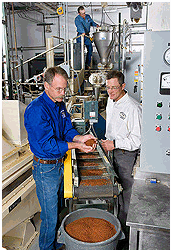The total amount of fish harvested for fishmeal has not changed in the last 20 years, but the demand has increased sharply. This pressure is thought by some to presage ecological problems and higher feed costs. So the search is on for alternative feed ingredients.

ARS scientists, led by fish physiologist Mr Rick Barrows, are attacking the problem from many angles, one of which is to use barley protein as a main ingredient in feeds. Researchers at the Small Grains and Potato Germplasm Research Unit in Aberdeen, Idaho, are examining barley’s genes to improve the grain’s protein yield and nutritional composition and developing ways to concentrate the protein. At the research unit, which is co-located at the University of Idaho’s Hagerman Fish Culture Experiment Station, geneticist Mr Ken Overturf is identifying genes in trout that may allow the fish to better utilise fishmeal-free diets.
The research team is pursuing several approaches to enhance the use of barley protein in aquafeeds. One is to produce a highly valuable co-product, beta-glucan, for the human nutraceutical industry while also producing barley protein for fish. Geneticist Mr Gongshe Hu has selected varieties that will yield high levels of beta-glucan as well as protein.
Another approach is to concentrate the protein in standard field barley into a form usable in aquaculture feeds. Mr Keshun Liu, a chemist at Aberdeen, is evaluating both wet and dry fractionation methods of concentrating the protein. Mr Barrows and researchers with cooperative research and development agreement partner Montana Microbial Products (MMP) of Butte, Montana, applied for a patent on a new enzymatic method that concentrates barley protein and produces raw material for another valuable commodity—ethanol.
“This process has provided a high-protein ingredient that may replace other, more expensive protein sources,” says Mr Barrows.
“We conducted feeding trials to determine the digestibility of macronutrients and amino acids in the barley protein concentrate. The data from these trials allowed us to formulate trout feeds with varying levels of barley protein concentrate, and we successfully replaced both fishmeal and soy protein concentrate.
“There is no current commercialization of barley protein concentrate in place, but MMP is producing pilot quantities for feeding studies in trout, salmon, and other species. MMP projects that the concentrate will sell for $700 to $1,200 per ton,” says Mr Barrows. Since fishmeal costs about $1,200 per ton, and fish oil costs about $2,200 per ton, the projected costs of barley protein concentrate compare favorably.
“Feed is part of a complex interplay of genetics, nutrition, and economics,” says Mr Barrows. “We believe barley protein concentrate can completely replace fishmeal if other essential nutrients are supplemented. We will also examine oats as another fish-feed alternative.”

